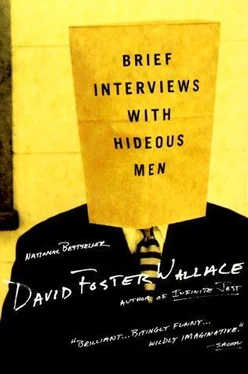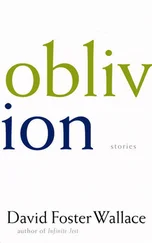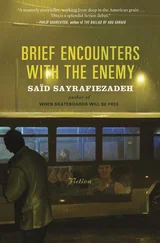David Wallace - Brief Interviews with Hideous Men
Здесь есть возможность читать онлайн «David Wallace - Brief Interviews with Hideous Men» весь текст электронной книги совершенно бесплатно (целиком полную версию без сокращений). В некоторых случаях можно слушать аудио, скачать через торрент в формате fb2 и присутствует краткое содержание. Год выпуска: 2007, Издательство: Back Bay Books, Жанр: Современная проза, на английском языке. Описание произведения, (предисловие) а так же отзывы посетителей доступны на портале библиотеки ЛибКат.
- Название:Brief Interviews with Hideous Men
- Автор:
- Издательство:Back Bay Books
- Жанр:
- Год:2007
- ISBN:нет данных
- Рейтинг книги:3 / 5. Голосов: 1
-
Избранное:Добавить в избранное
- Отзывы:
-
Ваша оценка:
- 60
- 1
- 2
- 3
- 4
- 5
Brief Interviews with Hideous Men: краткое содержание, описание и аннотация
Предлагаем к чтению аннотацию, описание, краткое содержание или предисловие (зависит от того, что написал сам автор книги «Brief Interviews with Hideous Men»). Если вы не нашли необходимую информацию о книге — напишите в комментариях, мы постараемся отыскать её.
Brief Interviews with Hideous Men — читать онлайн бесплатно полную книгу (весь текст) целиком
Ниже представлен текст книги, разбитый по страницам. Система сохранения места последней прочитанной страницы, позволяет с удобством читать онлайн бесплатно книгу «Brief Interviews with Hideous Men», без необходимости каждый раз заново искать на чём Вы остановились. Поставьте закладку, и сможете в любой момент перейти на страницу, на которой закончили чтение.
Интервал:
Закладка:
The face in the well-oiled doors’ crack hung, I inert, the face neckless and floating unsupported in the cleavage of the angled doors, the concentration of its affect somewhere between sport and assault, Da’s shaggy head cocked and sightless at the tuner, two bars of strings distorted by the storm and snatches of voices found and lost again; and Mum intent on my skull and unable to see the white hair-framed face reproducing my own visage, copying me — for we called it that, ‘copying,’ and he knew how I hated it — and for me alone. And with such intensity and so little lag in following that his face less mimed than lampooned my own, made instantly distended and obscene whatever position my own face’s pieces assumed.
And how it became worse, then, in that kitchen of copper and tile and pine and burnt peat’s steam and static and sleet on the window in undulant waves, the air cold before me and scorching behind: as I became more agitated at the copying and the agitation registered — I felt it — on my face, the face of my brother would mimic and lampoon that agitation; I feeling then the increased agitation at the twinned imitation of my face’s distress, his registering and distorting that new distress, all as I became more and more agitated behind the cloth Mum had fastened over my mouth to protest my disturbing her shears’ assertion of my face’s true shape. It ascended by levels: Da’s cameo recessed against the glow of the tuner’s parade, the drawer of utensils withdrawn past its fulcrum, the disembodied face of my brother miming and distorting my desperate attempts by expression alone to make Mum look up from me and see him, I no longer feeling my features’ movements so much as seeing them on that writhing white face against the pantry’s black, the throttle-popped eyes and cheeks ballooning against the gag’s restraint, Mum squatting chairside to even my ears, my face before us both farther and farther from my own control as I saw in his twin face what all lolly-smeared hand-held brats must see in the funhouse mirror — the gross and pitiless sameness, the distortion in which there is, tiny, at the center, something cruelly true about the we who leer and woggle at stick necks and concave skulls, goggling eyes that swell to the edges — as the mimicry ascended reflected levels to become finally the burlesque of a wet hysteria that plastered cut strands to a wet white brow, the strangled man’s sobs blocked by cloth, storm’s thrum and electric hiss and Da’s mutter against the lalation of shears meant for lambs, an unseen fit that sent my eyes upward again and again into their own shocked white, knowing past sight that my twin’s face would show the same, to mock it — until the last refuge was slackness, giving up the ghost completely for a blank slack gagged mask’s mindless stare — unseen and — seeing — into a mirror I could not know or feel myself without. No not ever again.
Notes
1 Also the first American-born poet ever in the Nobel Prize for Literature’s distinguished 94-year history to receive it, the coveted Nobel Prize for Literature.
2 Never the recipient of a John Simon Guggenheim Foundation Fellowship, however: thrice rejected early in his career, he had reason to believe that something personal and/or political was afoot with the Guggenheim Fellowship committee, and had decided that he’d simply be damned, starve utterly, before he would ever again hire a graduate assistant to fill out the tiresome triplicate Guggenheim Foundation Fellowship application and go through the tiresome contemptible farce of ‘objective’ consideration ever again.
3 That is not wholly true.
1 The multiform shapes the therapist’s mated fingers assumed nearly always resembled, for the depressed person, various forms of geometrically diverse cages, an association which the depressed person had not shared with the therapist because its symbolic significance seemed too overt and simple-minded to waste their time together on. The therapist’s fingernails were long and shapely and well maintained, whereas the depressed person’s fingernails were compulsively bitten so short and ragged that the quick sometimes protruded and began spontaneously to bleed.
2 (i.e., one of which purulent wounds)
3 The depressed person’s therapist was always extremely careful to avoid appearing to judge or blame the depressed person for clinging to her defenses, or to suggest that the depressed person had in any way consciously chosen or chosen to cling to a chronic depression whose agony made her (i.e., the depressed person’s) every waking hour feel like more than any person could possibly endure. This renunciation of judgment or imposed value was held by the therapeutic school in which the therapist’s philosophy of healing had evolved over almost fifteen years of clinical experience to be integral to the combination of unconditional support and complete honesty about feelings which composed the nurturing professionalism required for a productive therapeutic journey toward authenticity and intrapersonal wholeness. Defenses against intimacy, the depressed person’s therapist’s experiential theory held, were nearly always arrested or vestigial survival-mechanisms; i.e., they had, at one time, been environmentally appropriate and necessary and had very probably served to shield a defenseless childhood psyche against potentially unbearable trauma, but in nearly all cases they (i.e., the defense-mechanisms) had become inappropriately imprinted and arrested and were now, in adulthood, no longer environmentally appropriate and in fact now, paradoxically, actually caused a great deal more trauma and pain than they prevented. Nevertheless, the therapist had made it clear from the outset that she was in no way going to pressure, hector, cajole, argue, persuade, flummox, trick, harangue, shame, or manipulate the depressed person into letting go of her arrested or vestigial defenses before she (i.e., the depressed person) felt ready and able to risk taking the leap of faith in her own internal resources and self-esteem and personal growth and healing to do so (i.e., to leave the nest of her defenses and freely and joyfully fly).
4 The therapist — who was substantially older than the depressed person but still younger than the depressed person’s mother, and who, other than in the condition of her fingernails, resembled that mother in almost no physical or stylistic respects — sometimes annoyed the depressed person with her habit of making a digiform cage in her lap and changing the shapes of the cage and gazing down at the geometrically diverse cages during their work together. Over time, however, as the therapeutic relationship deepened in terms of intimacy and sharing and trust, the sight of the digiform cages irked the depressed person less and less, eventually becoming little more than a distraction. Far more problematic in terms of the depressed person’s trust and self-esteem-issues was the therapist’s habit of from time to time glancing up very quickly at the large sunburst-design clock on the wall behind the suede easy chair in which the depressed person customarily sat during their time together, glancing (i.e., the therapist glancing) very quickly and almost furtively at the clock, such that what came to bother the depressed person more and more over time was not that the therapist was looking at the clock but that the therapist was apparently trying to hide or disguise the fact that she was looking at the clock. The depressed person — who was agonizingly sensitive, she admitted, to the possibility that anyone she was trying to reach out and share with was secretly bored or repelled or desperate to get away from her as quickly as possible, and was commensurately hypervigilant about any slight movements or gestures which might imply that a listener was conscious of the time or eager for time to pass, and never once failed to notice when the therapist glanced ever so quickly either up at the clock or down at the slender, elegant wristwatch whose timepiece rested hidden from the depressed person’s view against the underside of the therapist’s slim wrist — had finally, late in the first year of the therapeutic relationship, broken into sobs and shared that it made her feel totally demeaned and invalidated whenever the therapist appeared to try to hide the fact that she wished to know the exact time. Much of the depressed person’s work with the therapist in the first year of her (i.e., the depressed person’s) journey toward healing and intrapersonal wholeness had concerned her feelings of being uniquely and repulsively boring or convoluted or pathetically self-involved, and of not being able to trust that there was genuine interest and compassion and caring on the part of a person to whom she was reaching out for support; and in fact the therapeutic relationship’s first significant breakthrough, the depressed person told members of her Support System in the agonizing period following the therapist’s death, had come when the depressed person, late in the therapeutic relationship’s second year, had gotten sufficiently in touch with her own inner worth and resources to be able to share assertively with the therapist that she (i.e., the respectful but assertive depressed person) would prefer it if the therapist would simply look openly up at the helioform clock or openly turn her wrist over to look at the underside’s wristwatch instead of apparently believing — or at least engaging in behavior which made it appear, from the depressed person’s admittedly hypersensitive perspective, as if the therapist believed — that the depressed person could be fooled by her dishonestly sneaking an observation of the time into some gesture that tried to look like a meaningless glance at the wall or an absent manipulation of the cagelike digiform shape in her lap.
Читать дальшеИнтервал:
Закладка:
Похожие книги на «Brief Interviews with Hideous Men»
Представляем Вашему вниманию похожие книги на «Brief Interviews with Hideous Men» списком для выбора. Мы отобрали схожую по названию и смыслу литературу в надежде предоставить читателям больше вариантов отыскать новые, интересные, ещё непрочитанные произведения.
Обсуждение, отзывы о книге «Brief Interviews with Hideous Men» и просто собственные мнения читателей. Оставьте ваши комментарии, напишите, что Вы думаете о произведении, его смысле или главных героях. Укажите что конкретно понравилось, а что нет, и почему Вы так считаете.











